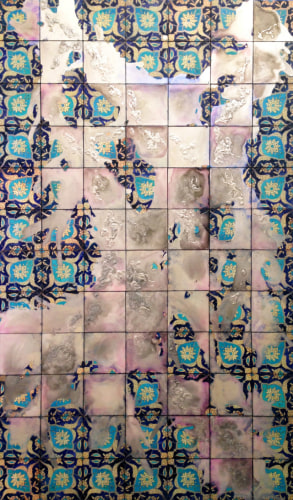
At a packed reception for Hedieh Javanshir Ilchi’s first solo exhibition at Hemphill, a restorative enthusiasm filled the space along with 26 paintings, all but three of which were completed this year. That enthusiasm seemed to emerge alongside a body of work that affirms the continued relevancy of painting.
In a media-saturated culture, painting is often obviated by excessive reproducibility, its essential meaning and experiential qualities lost somewhere in an Instagram feed. But it’s those conditions that position painting as a unique means to question that culture, its co-optimization of our visual world, and present new possibilities for the two-dimensional surfaces to which we seem so tethered. Painters are then challenged to push the medium in unexpected ways and engage viewers in discerning contemplation, while still presenting a surface pleasing to look at. It’s an unenviable task.
The paintings of Hedieh Javanshir Ilchi immediately materialize before the viewer as something fresh and consuming. The fluidity of her medium, usually a combination of acrylic and watercolor, and a striking palette saturate the surfaces in an indissoluble application where the artist’s hand is unnoticeable. Like several in the exhibition, the titular painting “Everything became nearness and all the nearness turned to stone” is a work on Mylar. The large, rectangular piece is the first encountered in the space and the rhythmic motion of the paint appears aided by that slick, lightweight surface. The Mylar is a thin stage for the intense colors that in their graceful motion seem to break free of the surface and hover in the viewer’s visual field.
Ilchi sometimes interrupts this approach with graphic patterning that references the intricacies of geometric form inherent in Persian decorative arts and here specifically Tazhib, or book illuminations. An effective broach of identity in painting, particularly through abstract form, is difficult to achieve. Ilchi’s fusion of loose, gestural application with precise line work appears seamless rather than forced, and imparts the contradictions of transcultural identity. Not only is contradiction implied through two different approaches to abstraction, but in works like “I have felt the shape that parting takes” Ilchi’s titles cross-reference the importance of poetry in Iranian culture with a line by the Austrian poet Rainer Maria Rilke.
Aided by the titles, some works are emotively suggestive of love gone either right or wrong, while other series like “I am silent, for I have seen nothing” are predicated upon a penchant for geographic references toward identity politics in contemporary art. Ilchi’s appropriation of maps in these works feels more pedantic and restricted than those that rely more heavily on abstraction and are perhaps more romantically titled. Her application of texts affirm the historic role of poetry in Iran as an art that has served both spiritual and political transformation, the conditions for which our own culture is in dire need. Ilchi aligns painting as an equal vehicle in that mission, creating works that are both mystifying and hauntingly present.